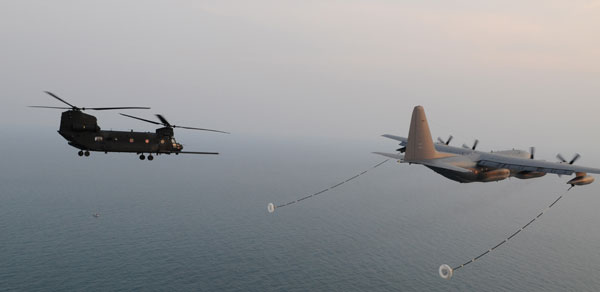UK Looks At Helicopter In-Flight Refueling.
21.01.2016
The U.K. Military is looking into ways to increase the operational range of its helicopters, including via air to air refuelling.[1]
The Strategic Defence and Security Review, published last November, promised to "upgrade helicopters and transport aircraft so we can deploy further, faster and independently, to meet the threats around the world".
Speaking at the IQPC International Military Helicopter 2016 conference, Maj Gen Richard Felton, the head of Joint Helicopter Command (JHC), indicated that the upgraded capability would be limited to "specific operations and missions", a reference, most likely, to special operations.
While Felton was keen to stress that things are at a very early stage, the U.K. are considering a number of options to meet the goal set out by the SDSR.
Due to budget constraints, it would seem that buying a new aircraft such as the V-22 Osprey (a tilt-rotor design with greater speed and range than traditional helicopters) is less likely to happen. The other option then, is to extend the range of existing aircraft.
One option would be to give aircraft larger internal fuel tanks. Such a move would, however, result in reduced performance and transport capacity.
Another option being mulled is to develop some form of rotary wing air-to-air refuelling (AAR) capability. There are several hurdles to overcome in order to gain such a capability.
The helicopters themselves would need to be given refuelling probes and the associated plumbing, and the crews would need additional training. Of the helicopter types operated by the U.K. in the special ops role, the Chinook would seem to be the best candidate for AAR refueling. AAR-capable variants of the Chinook are flown by other militaries (notably the United States, see photo below) and the type has a proven AAR track record.

A bigger issue for the UK is on the tanker-side of the AAR equation. The RAF currently only operates the Voyager tanker, which cannot fly at low enough speeds to enable helicopter AAR. So, we will either have to develop our own specialised tanker fleet or rely on another country.
To establish its own organic helicopter AAR capability, the UK would either need to modify aircraft from the current fleet or buy in new aircraft. In either case, the most likely aircraft type is the C-130j Hercules. The type is proven in the rotary wing AAR role (see above photo). The RAF already operate the type, and plan to keep it in service to 2030, so either a new buy or modified aircraft have the support infrastructure in place.
It may be that a number of the C-130J Hercules earmarked to support the Special Forces through to 2030 will be converted to act as tankers. Like the MC-130J Commando II aircraft in the U.S. Air Force inventory, in addition to AAR, they will still be able to carry out the insertion, extraction and resupply roles.
In a November blog entry, this site looked at the differing capabilities of British and American Chinooks in the special operations role. The upshot was that, due to lack of AAR capability, the ability of our Special Forces to carry out certain missions was significantly hampered. While it is very early days, and it remains to be seen where this tentative news on helicopter AAR leads, there seems to be some hope that the Special Forces will eventually get a significant boost in capability.
More info / further reading
- 1. UK eyes potential for in-flight refuelling of helicopters
(Flightglobal)








